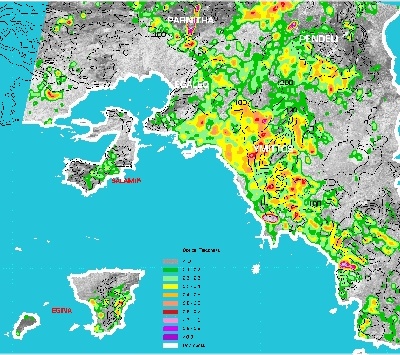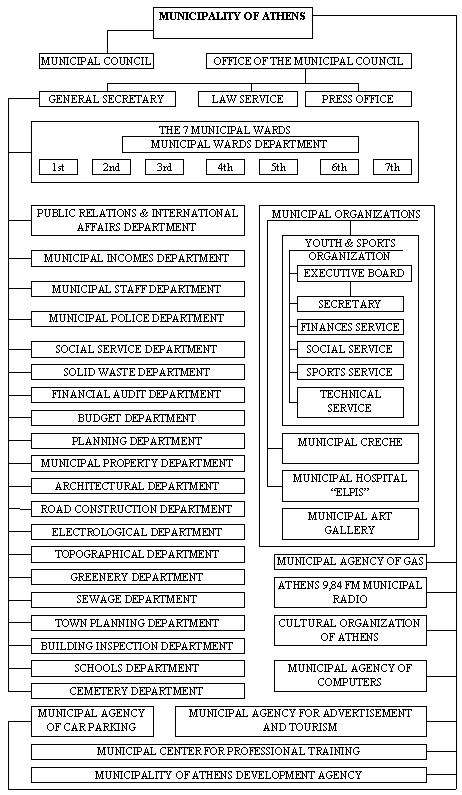
Documentation / Online Handbook
| The Municipality of Athens |

Athens is situated in the central eastern part of Greece, in the region ("Periferia")of Attiki. The population of the Greater Athens reached 3,098,775 on an area of 427 km², the Municipality of Athens covers 37,732 ha and has 784,110 inhabitants.
The green areas are representing 10.3 % of the total area of the Municipality of Athens and the areas free of construction 14.3 %. The urban area is mostly located in a basin surrounded by four mountains: Egaleo, Parnitha, Penteli and Hymittos. This basin has an opening towards the Saronic gulf at the South. The city enjoys a pleasant Mediterranean climate, with a high rate of sunny days.
Despite its 7000 years of uninterrupted history, Athens is a virtually new city. In 1833, being a small town of a few thousands inhabitants, it was selected as the capital of the newly founded Hellenic State, because of its glorious past and beauty of scenery. The glorious past became the driving force of its recent evolution, based on the historical memory of a society that gave birth to democracy, and through it, meaning and content to the ultimate concept of the city.
The new-born capital inherited many remnants of its past: the famous monuments of the classical period, but also remnants of the Hellenistic and Roman periods, most of them located in the extensive archaeological zone of central Athens. It also inherited numerous Byzantine churches scattered throughout the urban tissue of the Historic District.
The city’s growth surpassed all expectations. Its population reached 42,000 in 1862, and 68,000 in 1871. A significant change happened after 1922, when the mass expulsion of 1,500,000 Greeks from Asia Minor took place. The population of Athens grew then by 60 % within a few weeks. This caused an unprecedented unbalance, which the city hardly overcame in the years that followed.
During the post-war reconstruction period, Athens was expanded rapidly, through the incorporation of peripheral areas of illegal settlements, which lacked basic technical and social infrastructure. At the same time the intensive urbanisation damaged a great part of the quality of the old city center.
This evolution was accompanied by deep socio-economic change, as, with the advent of industrialization, a productive economy replaced the meager economy of the 19th century city. Today, Athens accounts for approximately 50 % of the country’s manufacturing and tertiary production and contributes about one half (54 %) of the GNP. It also accommodates the better part of all government and administrative, scientific and research, political and cultural activity of the country. Due to its international airport and to the international port of Piraeus, it is also a significant transportation hub on a supra-national level.
Contemporary problems.
The uncontrolled urban sprawl and the over-exploitation of urban space caused several environmental problems of the contemporary urban area. These are basically the lack of open areas, of social infrastructure and public facilities, the lack of hierarchy and differentiation in the city’s general structure. Moreover, the extreme concentration of population and activities caused a heavy congestion in all aspects of urban function, including the road network, the traffic and urban transport. The damages of the natural resources became another important factor of environmental degradation. Air-pollution, caused not only by the excessive use of the private car, but also by the high median age of vehicles used, their inadequate maintenance, and the low quality of fuel.
The urban renovation and upgrading of the environmental conditions was prevented by high land values and inefficient city management structures. In 1985, a new regional plan for the Greater Athens area was passed in order to regulate this undesirable situation. It established the new concept of decentralisation through a series of regional centers as primary poles of attraction within the urbanised area.
Regional and city plans for Athens.
In 1988, on the basis of the regional plan, new city plans were produced for every municipality of Greater Athens. These plans, with respect to the goals set by the regional one, determine the basic operations for the reorganisation of the city. They propose:
Among the fundamental elements of this strategy it can be mentioned the fight against pollution and environmental pressure in general, the development of new green areas, the regeneration of the neighbourhoods, the promotion of Athens as the focal point of the Classical values and culture. These objectives can be achieved by the following aims:
The implementation projects can be grouped into three categories:
The overall development includes the new lines of the metro system, which are expected to function in 1999, and the projects regarding the Olympic Games of 2004.
The involved administration: Municipality of Athens Development Agency (AEDA)
The Municipality of Athens Development Agency (AEDA) was established in September 1996 as a private enterprise with main shareholder the Municipality of Athens. Its goal is to develop activities and initiatives, as well as to provide services, that aim to the improvement of the quality of life in the city. Its objectives are the improvement of social life and of the environmental conditions and the advancement of the economic, scientific and cultural development.
In that framework AEDA has the following functions:
Apart from the Municipality of Athens shareholders of AEDA are the Local Association of Attica Local Governments (TEDKNA), the Athens Chamber of Trade and Industry, the University of Athens and the Technical University of Athens. AEDA has a highly specialized staff, on a wide range of disciplines (economy, environment, government, information sciences) with experience on the implementation of EU and other international programmes.
AEDA participates in national and international networks and cooperates with governmental and non-governmental organizations from Greece and abroad. Its main areas of interest are:
Reference adress ATHENS
MsTina Biribili
AEDA-Athens Development Agency
Favierou 5 – Mayer Street
GR-104382 ATHENS
tel.+30.1.522-1047 fax.-2743
e-mail: aeda@ath.forthnet.gr
